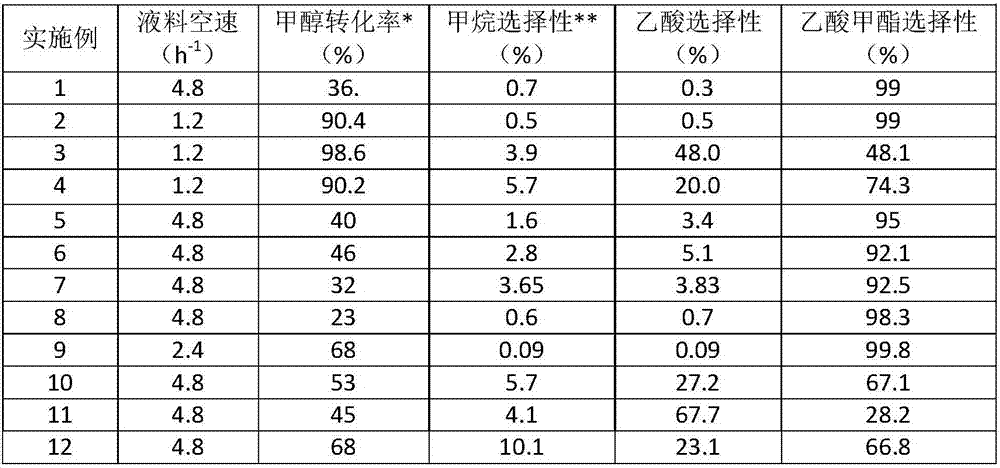Iridium-based catalyst supported by acid-treated carbon carrier, and preparation method and application thereof
A catalyst and acid treatment technology, applied in physical/chemical process catalysts, carbon monoxide or formate reaction preparation, chemical instruments and methods, etc., can solve the problems of low selectivity, low space-time yield, and deactivation of molecular sieve carbon deposits. , to achieve the effect of high selectivity, low methane content and reduced selectivity
- Summary
- Abstract
- Description
- Claims
- Application Information
AI Technical Summary
Problems solved by technology
Method used
Image
Examples
Embodiment 1
[0027] Weigh 8g of activated carbon, add 50ml of 1mol / L dilute nitric acid, cook at 60°C for 3 hours, wash with deionized water until neutral, and dry in an oven at 120°C to obtain acid-treated activated carbon. Weigh 3mL concentrated HCl and add 0.0128gLa 2 o 3 Stir until dissolved, then add 2.1ml of HCl with a concentration of 0.019g / mL to 3mL of hydrochloric acid solution 2 IrCl 6 ·6H 2 O aqueous solution, and then impregnated 1.5 g of the above-mentioned acid-treated coconut shell charcoal. Evaporate the solvent in a water bath at 80°C, dry in an oven at 120°C for 10 hours, and roast at 350°C under nitrogen protection for 4 hours to obtain an acid-treated iridium-based catalyst supported on a carbon carrier.
Embodiment 2
[0029] Weigh 8g of activated carbon, add 50ml of 1mol / L dilute nitric acid, cook at 60°C for 3 hours, wash with deionized water until neutral, and dry in an oven at 120°C to obtain acid-treated activated carbon. Then take 4.5g of the activated carbon from the previous step and react with 50ml of concentrated sulfuric acid at 180°C for 10h, wash with hot deionized water until neutral and free of sulfate ions, and oven-dry at 120°C to obtain sulfonic acid-treated activated carbon. Weigh 4mL concentrated HCl and add 0.0298gLa 2 o 3 Stir until dissolved, then add 4.943ml of HCl with a concentration of 0.019g / mL to 4mL of hydrochloric acid solution 2 IrCl 6 ·6H 2 O aqueous solution, and then impregnated 4 g of the above acid-treated activated carbon. Evaporate the solvent in a water bath at 80°C, dry in an oven at 120°C for 10 hours, and roast at 350°C under nitrogen protection for 4 hours to obtain an acid-treated activated carbon-supported iridium-based catalyst.
Embodiment 3
[0031] Weigh 4g of activated carbon and 50ml of concentrated sulfuric acid to react at 180°C for 10h, wash with deheated deionized water until neutral and free of sulfate ions, and dry in an oven at 120°C to obtain sulfonic acid-treated activated carbon. Weigh 3mL concentrated HCl and add 0.0213gLa 2 o 3 Stir until dissolved, then add 3.467ml of HCl with a concentration of 0.019g / mL to 3mL of hydrochloric acid solution 2 IrCl 6 ·6H 2O aqueous solution, then impregnated 2.5 g of the above acid-treated coconut shell charcoal. Evaporate the solvent in a water bath at 80°C, dry in an oven at 120°C for 10 hours, and roast at 350°C under nitrogen protection for 4 hours to obtain an acid-treated activated carbon-supported iridium-based catalyst
PUM
| Property | Measurement | Unit |
|---|---|---|
| pore size | aaaaa | aaaaa |
| pore size | aaaaa | aaaaa |
| pore size | aaaaa | aaaaa |
Abstract
Description
Claims
Application Information
 Login to View More
Login to View More - R&D
- Intellectual Property
- Life Sciences
- Materials
- Tech Scout
- Unparalleled Data Quality
- Higher Quality Content
- 60% Fewer Hallucinations
Browse by: Latest US Patents, China's latest patents, Technical Efficacy Thesaurus, Application Domain, Technology Topic, Popular Technical Reports.
© 2025 PatSnap. All rights reserved.Legal|Privacy policy|Modern Slavery Act Transparency Statement|Sitemap|About US| Contact US: help@patsnap.com

